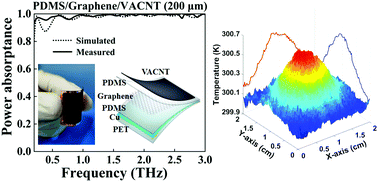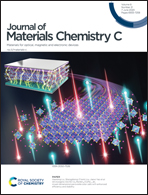A flexible and ultra-broadband terahertz wave absorber based on graphene–vertically aligned carbon nanotube hybrids†
Abstract
Electromagnetic wave absorbers are essential devices in imaging, wireless communication and energy harvesting systems. In this paper, we propose and experimentally demonstrate a flexible and ultra-broadband terahertz (THz) wave absorber based on graphene–vertically aligned carbon nanotube (G-VACNT) hybrids. The THz wave absorber consists of Cu/PDMS/graphene/VACNT functional layers on a PET substrate. The measured results show a 100% qualified operating bandwidth (i.e., absorptance >0.9) and an average power absorptance of 0.986 within the 0.2–3.0 THz range. The absorber also exhibits good absorption performances for a wide range of incident angles up to 60°, and can function normally in different bending states due to its excellent flexibility. The incoming energy of THz waves absorbed by the G-VACNT hybrids results in a temperature increase whose spatial distribution is corresponding to the profile of the incident THz beam, providing an efficient and low cost approach for THz beam profiling, collimation and focusing. This work paves the way for the development of large-scale and broadband THz wave absorbers.



 Please wait while we load your content...
Please wait while we load your content...